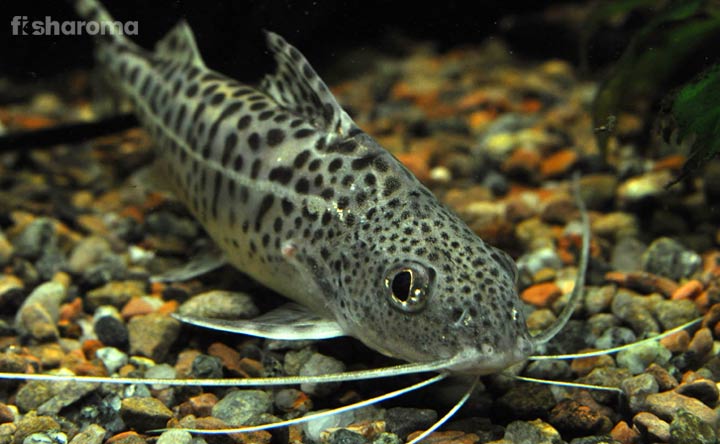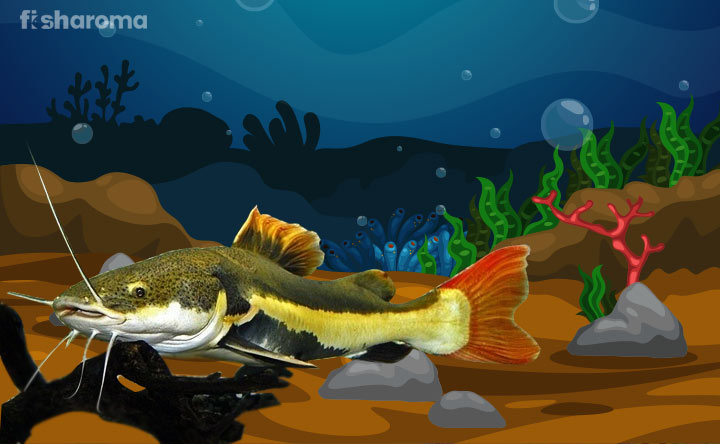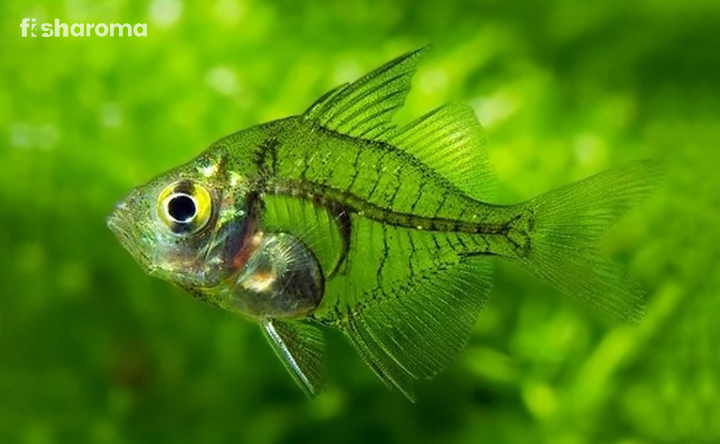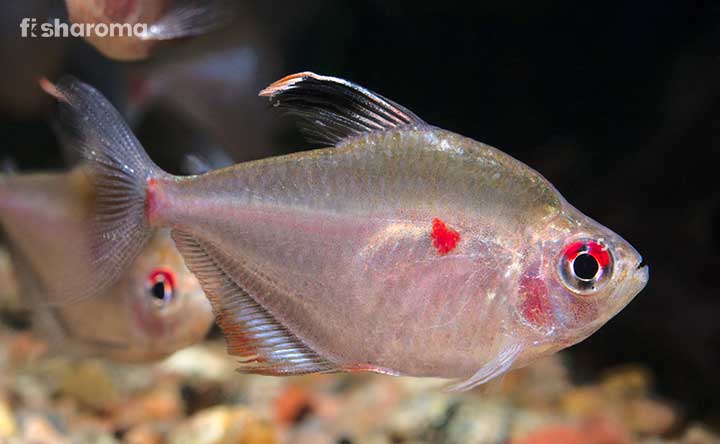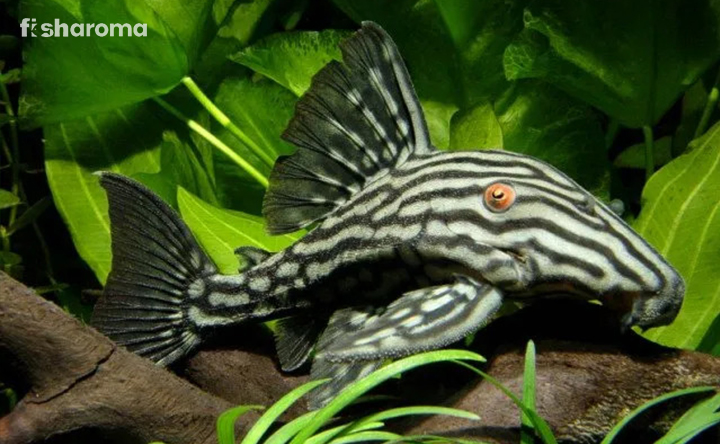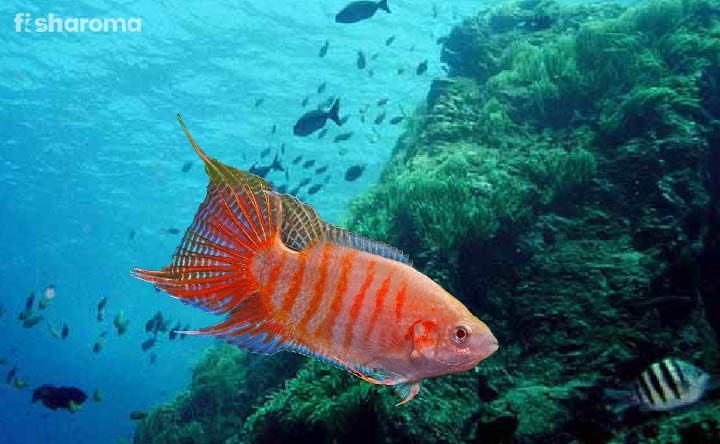Gold Gourami: A Thorough Care Guide To This Vibrantly Coloured Freshwater Fish
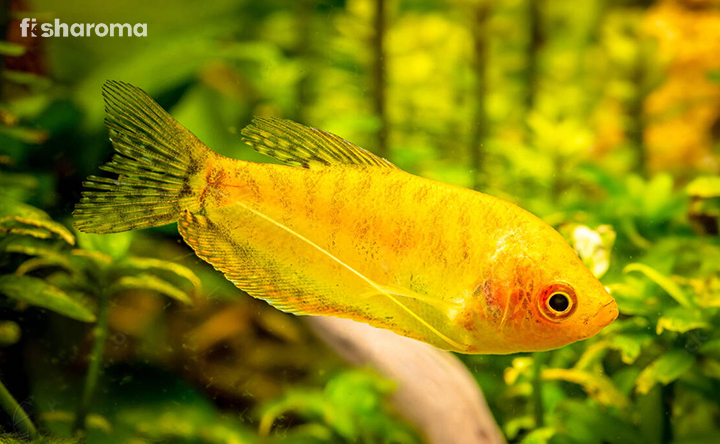
Gold Gourami is one of the variants of the Three Spot Gourami which also include the Opaline Gourami and the Blue Gourami. The Gold Gourami is a yellow colour morph of the Three Spotted Gourami as it lacks the other two colours. The orangish-yellow patterned coat of a Gold Gourami gives them a striking look.
The Gold Gourami is a community fish. Not only will their presence brighten up your mood, but they will also greatly adorn your tank. This species of Gourami is loved by many because it is comparatively easier to take care of them.
So, if you are really interested in having a Gold Gourami as your pet, then you’re at the exact right stop! Here, we will provide you with expert information and guidance on their care guide, diet, behaviour, breeding and other fascinating facts.
So, follow through to know it all!
Key Specifications of Gold Gourami
Gold Gouramis are very voguish and would make a great company. If you are really thinking about including them in your family then, the table below gives a brief outline of their primary characteristic traits. Let’s have a look!
| Scientific Name | Trichopodus trichopterus |
| Origin | South-East Asia and Indonesia |
| Lifespan | 4-6 years |
| Colour | Orangish-Yellow |
| Temperament | Semi-Aggressive |
| Size | 4.8- 6 inches |
| Diet | Omnivore |
| Family | Osphronemidae |
| Compatibility | Other similar-sized, inert fishes |
| Tank Size | 35 Gallons |
| Care Level | Easy |
| Water Temperature | 22.8 to 27.8 Degree Celsius |
| Water Conditions | pH 6.5-7.5 |
| Breeding | Egg-layer |
Overview
Gold Gourami (Trichopodus trichopterus) was previously scientifically known as Trichogaster trichopterus. They belong to the Actinopterygii class and Anabantiformes order. Gold Gouramis are admired by many because of their fiery and bright, orangish-yellow hue.
You will find your Gold Gourami swimming near the top and middle layer of the tank. That is another reason why they are bubble nest breeders as bubble nests are formed on the surface of the water. Gold Gouramis are very resilient, have a great personality and thrive in warm freshwater areas. There are several types of Gourami Fishes. You might wanna know about the kinds and further discover their uniqueness.
These Gouramis have a unique structure in their gills, called the labyrinth, which allows them to breathe air. This speciality of Gold Gouramis makes them even more popular amongst many fish-enthusiasts.
It is comparatively easier to take care of and breed Gold Gouramis. They do quite well with other semi-active and calm fishes.
Nevertheless, Gold Gouramis require sufficient care, maintenance and love. So, in this article today, we will delineate the facts and the essential measures that you need to take to make sure that your fish is leading a healthy and happy life in captivity.
Origin and Habitat of Gold Gourami
The Gold Gourami was developed in captivity for the fish-keeping business. They are a variety of the Three-spot Gourami, which include Opaline Gourami, Blue Gourami and Gold Gourami.
Gold Gouramis inhabit and are found extensively in South-eastern Asia and Indonesia. These species of fishes are primarily found in swamps, marshes, floating streams and canals.
Gold Gouramis populate areas of slack and stagnant water with a low current. However, their natural habitat is filled with abundant aquatic vegetation. They thrive in warm water temperatures and in a slightly acidic to neutral pH.
Appearance of Gold Gourami
As the name suggests, Gold Gouramis have a distinct golden tint to their skins. We’ll have a detailed look at their tones in the “colour” section below.
Gold Gouramis have an elongated and flattened body shape. They have broad-round fins. Their ventral fins are quite tender and they have soft, thread-like projections. The male Gold Gouramis have elongated and tempered dorsal fins, whereas the females have shorter and rounder dorsal fins.
Gold Gouramis are also known for their unique ability to breathe air and directly absorb oxygen from water. Thanks to the specialised labyrinth organ in their gills which makes them very hardy and resistant to many unfavourable conditions. This special feature confers them the ability to even survive in harsh conditions and stagnant water.
As we have seen earlier, Gold Gourami is a colour variation of the Three-spotted Gourami. So, let’s have a look at their immediate colour-morph neighbours and the varieties:
Opaline Gourami
Opaline Gouramis are equally loved by many aquarists because of their colour and marbled patterned coat. These Gouramis are not naturally occurring. They are a result of selective breeding between two Gourami species.
These Gouramis have a slight bluish tint to their skins. On their body, you’ll find cobalt-blue blotches here and there. This makes them even more attractive.
Blue Gourami
Blue Gouramis are a natural colour variation of the Three-spotted Gourami and they have a whitish-blue hue to their skins. These Gouramis have two distinct spots at the centre of their bodies and at the beginning of their tails. The eye colour of these Gouramis contributes to the third spot.
Platinum Gourami
These Gouramis have been developed in captivity by breeders who performed selective breeding between two Gourami species to get the platinum/silver colouration.
These Gouramis have a subtle silver-toned coat with hues of white and yellow undertones. They lack the two dark spots typical of a Three-spot Gourami because of the genetic modification.
Lavender Gourami
Lavender Gouramis are the result of cross-breeding between Blue and Gold Gourami. Two distinct spots, typical of Three-spot gourami, are visible on the centre of its body and at the beginning of the tail.
They have a light brown and lavender hue to their skins. Their fins have blue and orange colouration.
Size
Gold Gouramis can reach a maximum length of about 6 inches. However, they attain a smaller size in an aquarium environment.
These fishes are capable of breeding when they reach a size of 3 inches.
Colour
Gold Gouramis have a bright orangish-yellow tint to their coats. You’ll also notice that the colours turn into a striped pattern near the rear end of the fish’s body.
Behaviour of Gold Gourami
Gold Gourami is semi-aggressive in nature. As they grow old, they mature and tend to show more aggressiveness. In the presence of other larger and hostile species of fishes, Gold Gouramis will feel threatened and the resulting stress may lead them to lose colouration and turn pale.
A Gold Gourami’s belligerent behaviour is primarily characterised by them attacking, hunting and bumping into other tank fishes.
Gold Gouramis love to explore and slow-swim around the tank.
Lifespan of Gold Gourami
Gold Gouramis generally survive for 4-6 years. They can even live longer if you properly take care of them and provide accurate tank conditions.
Diet of Gold Gourami
Gold Gouramis follow an omnivorous diet. You should include equal amounts of meat and veggies in their diet. You should feed your Gold Gourami once or twice a day.
Vegetarian Diet includes
- Zucchini
- Lettuce
- Spinach
- Cucumbers
- Peas
- Brocolli
Commercially available food:
- Fish pellets and flakes
- Frozen Fish food
They also feed on:
- Small fish
- Dwarf Shrimp
- Bloodworms
- Insect larvae
- Zooplankton
Tank Requirements of Gold Gourami
Gold Gouramis are extremely beautiful and precious. So, they require diligent care and maintenance. You should pay keen attention to their needs, tank requirements and lifestyle.
In this section, we will help you out with easy yet expert guidance on the tank requirements of these gorgeous species of fishes. Get detailed guidance on setting up a fish tank.
Tank Size
For a Gold Gourami, you should get a minimum tank size of 35 Gallons. For the juvenile fishes, a tank size of 15-20 Gallons would do just fine. You should choose the perfect fish tank for your pet fish.
Tank Shape
Gold Gouramis prefer to swim around freely and explore. So, a rectangular shaped tank is a right choice for them. Additionally, a rectangular-shaped tank will help them breathe more air.
You should avoid keeping your Gold Gourami in a fishbowl. Not only will this restrict oxygenation, but a sphere-shaped bowl will also make them feel claustrophobic and cause physical and psychological stress.
Tank Lid
Gold Gouramis are jumpers. So, a tank lid is a must. You don’t want your Gourami to jump off the tank and suffocate to death. Additionally, a tank lid also keeps the tank safe from dust particles and other harmful airborne substances.
Furthermore, if you have other pets at your home, like a dog or a cat, you should definitely consider a tank lid to prevent any sort of attack.
Make sure that the tank lid is tightly closed.
Substrate
Since Gold Gouramis are brightly coloured, you should consider adding a dark substrate material to the bottom of your tank. This will enhance their beauty.
Some great substrate options are gravel and sand. Additionally, a darker substrate will also conceal the hidden wastes within the substrate layers.
Always choose small-grained and blunt-edged sand and gravel particles. This will prevent your fish from getting bruised.
Filter
A proper filtration system is important for your Gold Gourami tank. A strong filtration technique will clean out all the waste material and toxins within the tank. Furthermore, a proper filter will also purify the air within the tank and improve ventilation.
However, since Gold Gouramis prefer to swim through gentle water currents, you should use sponge air filters.
Ornaments
For decorations, you should mimic the natural habitat of your Gold Gourami, inside your tank. Include plenty of hiding places like caves, soft rocks and driftwoods. Your Gourami would love to nibble on driftwood, as it is a good source of fibre for them.
Lighting
Gold Gouramis love to swim around in the middle and top layer of the tank. So quite naturally, when it comes to lighting, you should try to maintain a moderate to normal light intensity within the tank.
Presence of Flora
For a Gold Gourami fish tank, you should include dense vegetation. These Gouramis love to take shade beneath the floating plants. Some great flora options for a Gold Gourami tank are Hornwort, Duckweed, Anubias, Java Fern and Java Moss.
Cleaning Method
A powerful filtration system is important to keep the tank clean. These filters purify the water and allow adequate ventilation.
Make sure that you change 10% of the tank water at least once a week. Use a sponge to clean the glass/acrylic aquarium walls.
You should also consider getting an aquarium vacuum cleaner to remove the debris and wastes accumulated within the substrate layers. Don’t let the decomposing matter build up inside the tank.
Make sure that you are taking the right measures for cleaning your fish tank.
Water Types for Gold Gourami
When it comes to Gold Gouramis, then you should leave no stones unturned in taking the accurate measures to maintain the proper tank water conditions. These fishes are sensitive to slight, undesirable changes in the water parameters.
Always, make sure that you fully cycle the tank before you introduce your Gold Gourami to the aquarium.
Come, let’s have a look at their water requirements.
Water Temperature
Gold Gouramis thrive the best at a water temperature between 22.8 to 27.8 Degree Celsius. In their natural habitat, Gold Gouramis live in tropical water temperatures.
Gold Gouramis mainly swim through the top and middle layer, so make sure that the surface temperature of the water is the same as the room temperature.
pH Level
For a Gold Gourami tank, you should keep the water pH between 6.5 to 7.5. Gold Gouramis survive the best in slightly acidic to neutral pH.
So, you must maintain the proper pH level inside the tank.
Hardness
For a Gold Gourami, you need to make sure that the water hardness lies anywhere between 5 to 35 dGH.
Water Flow Rate
Gold Gouramis don’t love to swim through a strong water current. They prefer roaming around in areas that have a measured and slow water flow rate.
So, you can install a pump inside your tank to maintain the flow rate of water.
Compatibility of Gold Gourami
Gold Gouramis typically are very calm and welcoming of other similar sized and peaceful fishes. However, they are semi-aggressive and as they mature, they tend to show signs. You should avoid keeping larger-sized and more aggressive species of fishes in your Gold Gourami tank. There are high chances that they’ll end up fighting.
Furthermore, you must pay keen attention to whether the other tankmates are fin nippers. Gold Gouramis have a long pelvic fin and they are slow-moving. A fin nipper will not only attack your Gold Gourami, but it will also make them more prone to infection, fatal injuries and stress. If kept unnoticed, this might kill your Gold Gourami.
On a positive note, Gold Gouramis are slow-moving fishes who love to explore. So, choose their tank mates wisely.
Suitable Tank Mates
- Cherry Barb
- Plecostomus
- Characins
- Loricariid Catfish
- Yoyo Loach
- Kuhli Loach
- Mystery snails
Unsuitable Tank Mates
- Tiger Barb
- Angel Fish
- Red Tail sharks
- Other aquarium Fin nippers
Breeding of Gold Gourami
The bright golden colour of a Gold Gourami and the lack of other two colours, typical of a Three-spot Gourami, is a result of genetic mutation performed by the breeders. This is done by mating a selected pair of Gouramis to produce the desired offspring and colour.
You can easily allow their breeding inside your tank as it’s an easy process. To stimulate the mating instinct, you need to make sure that your Gold Gouramis are stress-free and happy. For this, you can feed them a few more times in a day, adding live and flavoured variations to their diet. To stimulate breeding you also need to raise the water temperature to about 26 Degrees Celsius.
For breeding, you need to get a separate tank of 15 Gallons. You should decorate the tank with floating plants and caves. Use a gentle sponge filtration technique. Make sure that the water current inside the tank is slow as Gold Gouramis don’t like a strong water current.
Technique
Gold Gouramis are bubble nest breeders. First, you need to introduce a healthy and compatible mating pair of Gold Gouramis inside your breeding tank.
The male will invest a lot of time in finding a place for building the bubble nest. Once the nest is built, the male Gold Gourami will entice the female to perform mating.
Once it’s successful, you’ll notice that the eggs will be floating on the surface of the water. These eggs are then eventually trapped inside the bubble nest.
You can expect a spawn of 700-800 eggs if the female has been well fed and develops a bulging belly.
What Should you do?
After the eggs are produced, you must remove the female from the tank or else the male Gold Gourami might attack and kill them. The male Gourami will take care of the eggs, and guard and protect them.
Once the eggs hatch and you see the fries, immediately remove the male Gourami from the tank as they will eat away their own offspring.
After the eggs hatch, the fries will soon start to swim. Now that they are all by themselves inside the tank, feed them well and take proper care of them. Feed them infusoria and fry food. Once they start to grow, you can feed them baby brine shrimps.
Disease and Treatment of Gold Gourami
Gold Gouramis, in general, are very hardy. They don’t get easily prone to bacterial or parasitic infections. However, you can’t ignore the chances! So, here are some common freshwater diseases that might affect your Gold Gourami.
Ich
Ich is a common freshwater disease that is caused by certain parasites. The most common symptoms include white spots all over the body and the tail, loss of appetite and lethargy.
For treatment, you must first isolate the infected fish to a separate tank. Then, make sure that you pay keen attention to cleaning up the tank.
Change the tank water at regular intervals and use a sponge to clean the inside of the tank glass/acrylic walls. Install a proper filtration system to remove any debris or waste materials inside the tank.
Consult the vet if the problem persists.
Dropsy, Fin and Tail Rot
These common freshwater diseases are caused by certain bacteria. The symptoms include a noticeable loss of colouration on the fish’s body. These types of diseases are mainly caused due to poor tank and water conditions.
For treatment, make sure that you change 25% of the tank water at least once a week and keep the tank clean.
Definitely consult the vet, if this takes a serious turn.
Holes in the Head
As the name suggests, you’ll notice several cavities in and around the head of the fish. Again, certain bacterias are responsible for this disease.
For treatment, ensure that you keep the tank clean and change the water. Medications including tetracycline and vitamin supplements can help cure the disease.
Consult the vet for expert and proper treatment.
Fungal Disease
If your Gold Gourami is infected by a fungus, then you’ll notice several grey and white spots all over their body. Lack of hygiene and poor tank conditions are the lead causes.
Consult an expert vet for treatment.
Additionally, as we have already seen before, if your Gold Gourami shares the tank with fin nippers, then there are high chances that their fins will get severely bruised and injured. This will ultimately lead to stress, infections and death.
So, in that case, it is a must that you consult the vet as soon as possible and look for an efficient and immediate treatment.
Summary
On a closing note, a Gold Gourami is an excellent choice if you are really looking forward to having them as one of your family members. Not only do they have an enchantingly vibrant colour, but their personality is also something that you will extremely fall in love with.
It is comparatively easier to care for Gold Gouramis. Even if you want to perform their breeding, the process won’t come out as much of a herculean task for you.
Gold Gouramis would be an excellent choice for beginner aquarists. Having a Gold Gourami as your pet will surely enthral you and alleviate your experience as an aquarist.
So, yes! All the best as you go ahead with your decision of getting a Gold Gourami for your freshwater aquarium. They will indeed make a great company.
Similar Care Guides
If this article interests you then, don’t forget to visit our sites for further similar care guides on different fishes.
- Care Guide for Moonlight Gourami: These Gourami species are stunningly beautiful and as the name suggests, they give out a luminous, moon-like hue. They are also extremely calm to watch.
- Care Guide for Pearl Gourami: These Gourami species would surely be an excellent addition to your tank. The white spots on their orangish-red hued body give out a pearl-like appearance.
- Care Guide for Paradise Gourami: Just as the name suggests, these fishes are paradisical and enchantingly beautiful. They require special care and maintenance but would certainly embellish your tank in a way that you never thought would have been possible.

